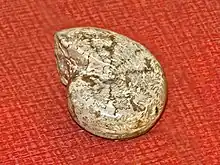| Cladiscites Temporal range: | |
|---|---|
 | |
| Polished fossil shell of Cladiscites species from Austria, on display at Galerie de paléontologie et d'anatomie comparée in Paris | |
| Scientific classification | |
| Kingdom: | |
| Phylum: | |
| Class: | |
| Subclass: | |
| Order: | |
| Family: | |
| Genus: | Cladiscites de Haan (1825) |
| Species[2] | |
| |
Cladiscites is an extinct genus of cephalopods in the ammonoid order Ceratitida. These nektonic carnivores [2] lived during the Triassic, from Carnian to Rhaetian age.[1]
Description
Shells of these cephalopods can reach a diameter of about 70–170 centimetres (28–67 in). This genus survived at the extinction event at the end of the Permian.[3]
Distribution
Fossils of species within this family have been found in the Triassic of Afghanistan, Hungary, Italy, Oman, Tajikistan, United States[2] and the East Indies.
References
- Notes
- 1 2 Sepkoski, Jack (2002). "Sepkoski's Online Genus Database". Retrieved 2014-05-28.
- 1 2 3 "Paleobiology Database - Cladiscites". Retrieved 2014-05-28.
- ↑ Museum of Victoria
- Weblinks
- James Perrin Smith Upper Triassic marine invertebrate faunas of North America
- Mikko's Phylogeny Archive
This article is issued from Wikipedia. The text is licensed under Creative Commons - Attribution - Sharealike. Additional terms may apply for the media files.